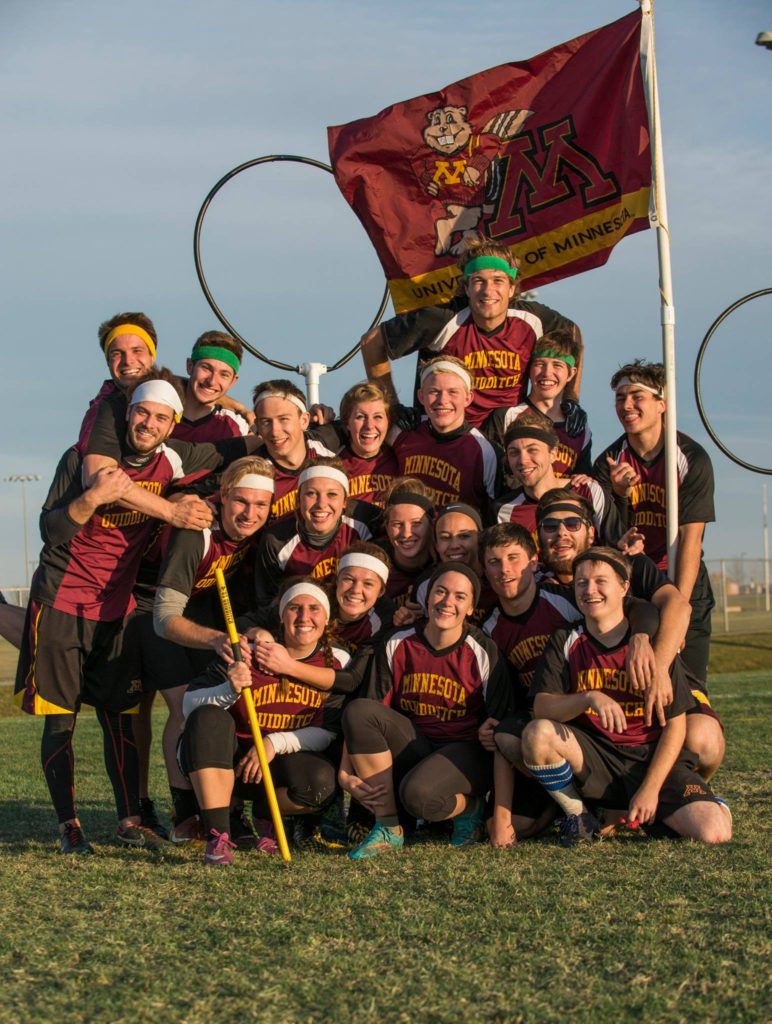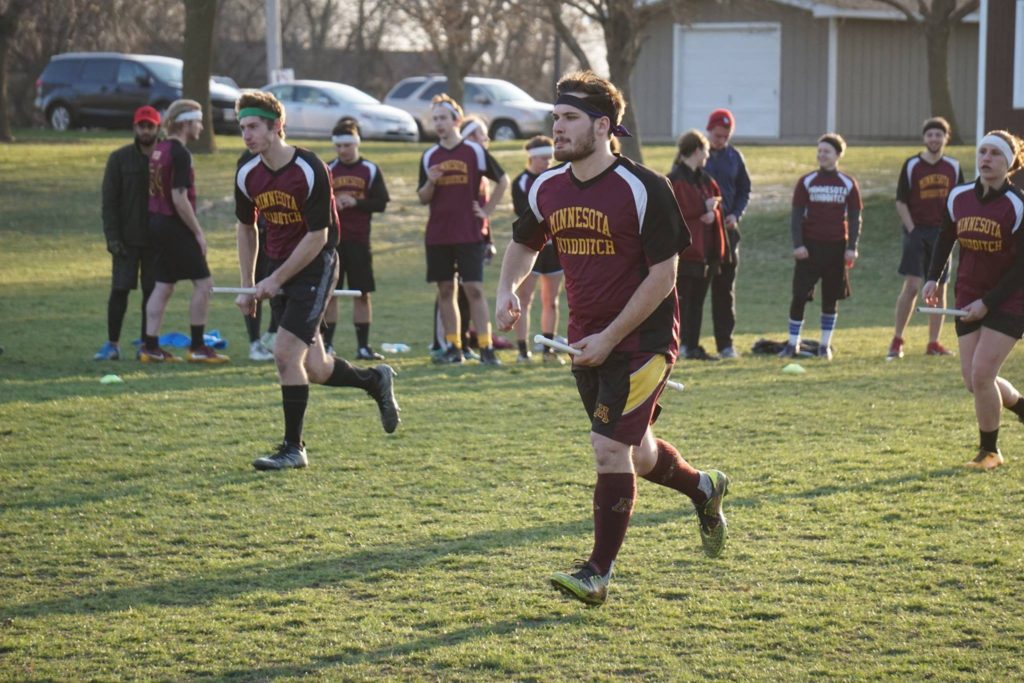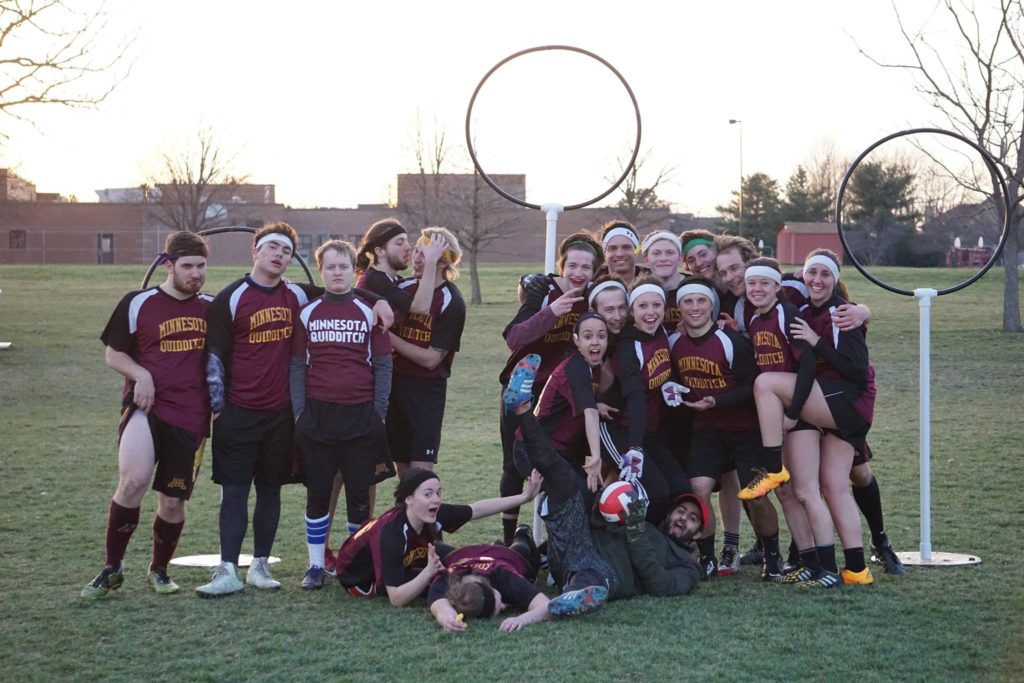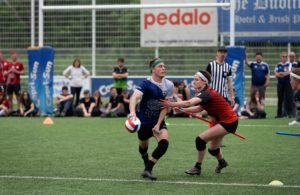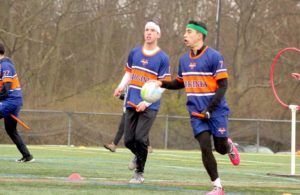- Rule, Britannia, no more?
- Unpopular Opinions: US Quadball Cup 2023
- Proven Contenders: University of Virginia
- Proven Contenders: Rutgers University
- Proven Contenders: University of Michigan
- Proven Contenders: Creighton University
- Different Perspectives: A Look Inside USA Ultimate
- Antwerp QC, Much of Belgian Core, Leaves Competitive Quidditch
Hats Off to Thee: The History of Minnesota Quidditch
This article is part of the “History of…” series curated by The Eighth Man and US Quidditch. The series highlights the individual histories of teams that qualified for US Quidditch Cup 10 to help both players and spectators get to know the story behind the teams. Head over to this link to read more.
Meet Minnesota
By Cole Wensman
Cole Wensman joined the University of Minnesota team as a freshman and quickly distinguished himself as a talented chaser and team leader. Wensman currently serves as chaser captain and intramural coordinator.
In 2010, a group of friends at the University of Minnesota decided to take a risk by founding a new student organization dedicated to playing a brand new sport. Seven years later, Minnesota has established itself as one of the top teams in the Midwest. It’s on-pitch success includes a Midwest Regional Championship, a remarkable run to the Final Four at Quidditch World Cup V and berths to the national championship in every year of its existence.
In addition to building a consistently competitive quidditch team, Minnesota has created a highly-successful intramural quidditch league at the University of Minnesota. While less competitive than the traveling team, the spirits of inclusiveness, camaraderie and competitiveness are easily seen by the more than 150 intramural players participating in our program. The intramural league gives everyone the opportunity to partake in a sport that was previously only playable in the imagination. In order to fund both the competitive team and the intramural league, Minnesota organizes a large Yule Ball once a year. Meeting capacity for the past two years, the dance features a DJ, student group performances, a photo booth, a Diagon Alley vendor experience and catered food including butterbeer and chocolate wands.
Each of these aspects of Minnesota define what the organization is and how it brings the quidditch community in the Twin Cities together like an extended family. Both on and off the field, Minnesota has successfully established itself as one of the premiere quidditch organizations in the country.
2010-11
By Luke Zak
Like Zak was a founder and original member of the team. He helped found and currently plays for TC Frost.
After mulling things over throughout the summer of 2010, a group of friends decided to make a go of this quidditch thing at the University of Minnesota. There were whispers of the sport being played at colleges around the state but all the leads turned up dry.The founders knew it was up to them to bring organized quidditch to the state of Minnesota. As such, the team was formed that August with a few goals in mind.
Because of its relative isolation, the first priority for the program was creating an intramural league so that anybody who wanted to play quidditch would have access to a regular outlet. The officers set out to register with the university administration, construct hoops, acquire a ridiculous amount of balls and brooms and plaster campus with fliers. Though their hopes were high, little could have prepared them for the turn out at the interest meetings, which were each attended by hundreds of students eager to get on the pitch.
Soon enough, Minnesota had over 100 people turning out for weekly matches. It was a full blown 10-game schedule every Sunday leading up to the Halloween Tournament, our fall championship event. Of the teams that participated, the intramural champion was to be chosen to represent Minnesota at World Cup IV in New York. That fall, Goldy’s Army would win the intramural title and the privilege of representing our organization at our first national tournament.
Two weeks later, the small squad and team leadership found themselves in the back of a fifth-wheel camper, road tripping across the country toward Dewitt Clinton Park. After nearly a full day of non-stop driving and minimal sleep, the team was marching along a procession among 46 other teams, joyously chanting the Minnesota Rouser and preparing for the program’s first-ever intercollegiate match. With an empowering victory over Green Mountain College, Minnesota appeared to be a contender in its pool. That feeling, however, proved to be short-lived as the rest of the day-one games ended in snitch-catch losses. But, in what can only be described as a clerical error, Minnesota was one of the 24 teams to make it to bracket play on day two. Bowing out in the play-in round to a veteran Boston University team, the Gophers returned to Minnesota not with heavy hearts but a newfound excitement and vigor for the future of the program.
In retrospect, the infrastructure established that season would lead to a still unrivaled intramural league, remarkable national tournament performances and unparalleled fundraising capabilities for a sport so unknown to the general public. This infrastructure contributed to Minnesota’s recognition as the 2010 recipient of the University of Minnesota Rookie Registered Student Organization Tony Diggs Excellence Award. Through the first year’s successes and thorough framework, the leadership had put the team on course to accomplish the last goal: establishing a program that would outlast them all.
2011-12
By Cody Narveson
Cody Narveson was an original member of Minnesota and played on the competitive team until 2015. He then co-founded the now defunct Minnesota Nice QC and currently plays for TC Frost.
Looking to build upon their first year of existence, Minnesota’s leadership sought out dedicated participants within the league and formed the club’s first board of officers, complete with nine members.
It was during this season that a committed group of athletes came together in what would become Minnesota’s first traveling roster. This team travelled to Fishers, Ind. for the first Midwest Regional Championship and to Marquette University for a three-game set–both trips saw Minnesota get outmatched in nearly every game. Knowing a big strategic shift was necessary, the Minnesota zone defense was conceived and refined in the week leading up to World Cup V. This setup allowed for the keeper and two chasers to guard a hoop apiece and for the beaters to float comfortably in the keeper zone with little threat of losing bludger possession. Many names for this strategy have cropped up over the years including the Hoop Zone, Three Trees and Baylor Defense. Using the newly-implemented zone, coupled with clutch seeker play, Minnesota advanced to the Final Four, before finally falling to University of Florida. This still stands as the team’s best national tournament performance to date.
The following spring Minnesota was invited to compete in the Champions Series in Boston, Mass. Thanks to brilliant organization following the invitation announcement, Minnesota ended up being one of the few teams in attendance to sport a full local squad, as many teams instead opted for regional all-star rosters. This chemistry favored Minnesota until the semifinals of bracket play, when a Villanova University featuring players from Penn State University’s squad ended Minnesota’s tournament run.
Minnesota’s 2011-12 season concluded with the selection of keeper Jared Sipe to represent the squad on Team USA at the first ever Global Games. Beater Ashley Novitsky was also chosen for the tournament as a reserve. More than anything, this was an indication to Minnesota personnel that their success and accomplishments as a team had not gone unnoticed and that they would be a team to watch going into the new season.
2012-13
By Tim Ohlert
Tim Ohlert played for Minnesota for four years, serving as beater captain for three. As a starting beater and captain, Ohlert helped lead the team to its 2015 Midwest Regional Championship berth.
Minnesota’s 2012-13 season yielded inconsistent results. The program achieved its first ever victory over rival Marquette and placed second at the Spring Breakout tournament in Missouri. But the successes of the season were tempered by an unremarkable Midwest Regional Championship tournament where the powerhouse bowed out early in bracket play despite high expectations. Furthermore, the team’s performance at World Cup VI ultimately resulted with an injury-depleted roster unable to make it past the opening day of the tournament, eliminated in pool play with a 1-3 record.
Despite the disappointing gameplay performances, the organization was still on the rise. A large group of freshmen had reinvigorated the structure of the program and the returning players from the World Cup V Final Four run were among the most knowledgeable in the game at the time, including Team USA’s Sipe. The vast majority of this team would return the following season, strengthened by new rookies. Everyone was ready to work harder and invest more into the game in order to avoid the shortfalls of the past season and take advantage of the rapidly growing program.
2013-14
By Cody Narveson
A strong class of rookies made the 2012-13 season a successful rebuilding year for Minnesota. Together, this group went into the 2013-14 season with the firm intent to make visible strides forward.
This year, Minnesota made the unorthodox decision to not pursue any official games prior to the Midwest Regional Championship, instead focusing on inter-team scrimmages and pick-up play against first-year community team TC Frost. The risk paid off, and Minnesota came out of the regional with a 3-1 pool play record, a bracket play overtime loss to a reinvented Marquette team and a bid to World Cup VII.
Minnesota was set to host its very first tournament in February but bad weather and unsafe driving conditions led to many teams dropping out the day before. What followed was a three-team round robin consisting of Minnesota, TC Frost and a mercenary team comprised of scattered Midwest players, including Minnesota native, Ball State University chaser and future Team USA beater Tyler Walker. A few weeks later, Minnesota travelled to Indiana to participate in the B1G/MAC Tournament, which was an event limited to schools from the Big Ten and Mid-American conferences. A blizzard and subsequently snowy conditions greatly aided Minnesota’s Hoop Zone defense throughout the event and the team came away with the tournament title.
Minnesota concluded its season by traveling to World Cup VII. With a 3-1 record in pool play, Minnesota had to settle for the third seed in their pool due to a low quaffle point differential through tough matchups. This was good for a bracket play-in round appearance, which ended with a snitch-range loss to Austin Quidditch.
This season’s ups and downs spoke to the ability of the team’s leadership to develop its returning player core and was an indication of Minnesota’s improving ability to recruit legitimate athletes raw with talent. A tournament championship is a worthy accomplishment for any team, even if it was earned on pitches comprised largely of snow and ice. If anything else, it fueled a World Cup bracket play appearance that year, which was a tangible step forward from the season before.
2014-15
By Hallie Schley
Hallie Schley joined Minnesota her freshman year and quickly made her mark as a talented beater. In her time there, Schley served as secretary, president and beater captain.
After losing a majority of the previous senior class, several fresh faces were added to the team for the this season. Minnesota had a good showing at Kansas Cup in the fall, going 6-2 despite losing three of their five female players to injury in the first two games. The team played nearly the entire day in the loser’s bracket after an early loss to Oklahoma State University. Minnesota was successful in a rematch against Oklahoma State later though, and with another key win against the University of Arkansas, Minnesota made a run to the finals before bowing out to the University of Kansas. Taking second place in Kansas was a good start to the season heading into Midwest Regional Championship.
At the Midwest Regional Championship, Minnesota had two tough pool play games against Michigan State University and rival Marquette but ended the first day with a 3-0 record. A win against Grand Valley State University on day two would reap a World Cup 8 bid, but, shortly after, the team was demolished by a veteran Bowling Green State University team in the quarterfinals.
In the spring, the team went 1-1 at Spring Breakout before the tournament was cancelled due to snow and took first place at a Purdue University tournament. At World Cup 8, the Gophers went 3-2 in pool play and qualified for bracket play on the strength of strong performances against top-tier teams. Unfortunately, the team matched up against tournament favorite, Lone Star Quidditch Club, and, despite a hard-fought game, could not overcome the eventual World Cup runners up.
2015-16
By Hallie Schley
The 2015-16 season started off with a bit of uncertainty.
Minnesota lost quite a few experienced players from the previous year to graduation, with additional players ultimately choosing to play for community teams. With the newly revamped Midwest region being allocated just four bids to nationals, a lot of work had to be done to build a team that could compete with the rest of the Midwest.
Fortunately for the squad, a group of talented freshman joined the team and developed quickly over the course of the fall. The Gophers kicked off fall 2015 with an excellent performance at the Marquette Fall Classic, finishing second place. The Midwest Regional Championship that year created challenging conditions, with a blizzard that started Friday and carried on through Saturday morning. Despite said conditions, Minnesota played well enough and utilized clutch performances against Minnesota Nice and University of Missouri to secure a spot in the final. Beating Illinois State University, 110*-40, was the highlight of Minnesota’s season.
In the spring, Minnesota lost the core of their quaffle game as David Pray, Cole Wensman and Paul Dvoracek were sidelined due to injuries, studied abroad and secured an internship, respectively. This depleted the Gophers’s roster leading up to nationals and led to a poor showing that semester. After a disappointing performance at Spring Breakout, the team desperately needed a change in direction and new guidance. Tookie Peter Nieman and veteran Zach Miller did what they could but at US Quidditch Cup 9, Minnesota ended the first day with a disappointing 1-3 record and failed to make bracket play. Even though the players did not live up to the high standards they had set for themselves, the framework for success was built. Moving forward, the young leadership and willingness to adapt under pressure would prove to be extremely useful to the team.
2016-Present Day
By Zach Miller
Zach Miller joined Minnesota his junior year of college. Prior to playing for the Gophers he chased for two years on TC Frost. When Miller joined Minnesota, he use his knowledge of the game to switch to beater. He also served as the first Intramural Coordinator for Minnesota.
In 2016, many returning players thought the year was going to be a time for rebuilding. Veteran beaters Ohlert, Schley and Carly Eichten left the team as well as front-line quaffle carriers Pray, Ben Spokely and Andrew Wagganer. The team looked weak.
When tryouts neared, Minnesota was in dire need of a freshmen class that could learn quickly and mesh well with the foundation that was last year’s freshmen. The team was very fortunate though and recruited a handful of capable playmakers that helped determine what style of play Minnesota would create for the season. The Gophers’s new-look squad was relatively overlooked from an athletic perspective. The team was predominantly skinny and tall with no large players. When you scratched the surface of the team, though, you found that what it lacked in physicality, it made up for with speed and cunning playmaking abilities.
After a lackluster second half of the 2015-16 season, Minnesota was in need of an overhaul. For 2016-17, the leadership on the team focused on revamping the team’s defense, increasing communication on pitch and developing similar aggressive beating strategies used by top-tier teams throughout the country. Chaser Dvoracek brought a lot of expertise in tackling from his season with the Lost Boys Quidditch Club. By addressing these issues head on and focusing on improving with the modern game, Minnesota heavily improved as a competitive team.
Minnesota ended fall 2016 11-4 with appearances at the Marquette Fall Classic, Kansas Cup and the Midwest Regional Championship. Many of these wins were not decisive; they often came down to snitch grabs or overtime victories. This success, however, has Minnesota sitting in USQ Standings as the third best team in the Midwest and with a US Quidditch Cup 10 qualification. As the squad moves forward, it hopes to open some eyes at US Quidditch Cup 10 with a play style that can keep up with some of the best teams in the country.
A Thriving Program
By Sarah Kollman
Sarah Kollman started playing quidditch her freshman year and is currently a beater on the Minnesota travel team. She also serves as secretary for the organization.
Since its beginnings in 2010, Minnesota has grown into an overall successful program. The Gophers’s presence has grown both at the University of Minnesota and in the surrounding community. The intramural league consistently has between 100 and 200 players, and is continually introducing quidditch to new people. Minnesota’s annual Yule Ball fundraiser has become an extremely successful public event, drawing nearly 800 attendees each of the past two years. Furthermore, the team constantly works to advance public knowledge of the club and the sport in general through activities such helping with youth programs in the summer and holding an informational booth at the Minnesota State Fair.
The travel team continues to act as the focal point of the organization, holding tryouts each fall and traveling to tournaments throughout the country during the regular season. Between the many practices and long car rides, team members have formed a special sort of camaraderie, becoming an ever-changing family as seniors graduate and new players are added each year. Throughout its existence, Minnesota has seen success due its presence on the pitch as well as in the university community and general public. Looking forward, the team hopes to continue the growth of its intramural league and community events, as well as maintain a competitive travel team. By recruiting new members and becoming more well-known each year, Minnesota’s members work to ensure that the team will be a flourishing organization for the years to come.
The original article incorrectly stated the blizzard at the 2015-16 Midwest Regional Championship lasted for the duration of Saturday. The article has since been corrected to state the blizzard only lasted through Saturday morning.

